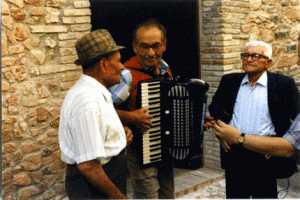 The panorama of Italian popular music took over – especially for some years now – a fairly undefined. On the one hand because in this area it is always hovering between radically different interpretations. There is the revival, the populism, revived the philological, the revived oriented to experimental forms. Then there is the academy, and then the scientific interpretation, and the horizon where you meet enthusiasts, connoisseurs, who often operate by making improvements in the environment, proposing laudable initiatives, suggesting necessary measures, etc. On the other hand, unfortunately, there is a market. Legato, as we all know well, to complex dynamics. Dynamics involving not only the artists but also the political, cultural workers and all those who try, with different interests, to promote the most diverse musical productions. In this context, the publishing industry – that I have not counted so far because it has been hit hard, most of all those mentioned above, the current economic crisis – has a role more meritorious than you can believe. Mainly for two reasons. First, because the books produced on popular music (whether scientific or popular) never meet the consensus of a large audience. So is the publisher that invests on the project with concrete cultural purposes. Secondly, because just to combat the crisis (where it was possible), they had the strength to regroup, promoting written culture online. And refining, in recent years, a balanced proposal between disclosure and scientific investigation. Abroad, this dynamic is very structured and online versions of the great magazine (fRoots and Songlines first of all) are now spaces multimedia fundamental for those working in these areas. In Italy we had some attempts in this direction but the magazine that most of all managed to summarize the international orientation – giving account of the horizon of international productions or trad music world – is undoubtedly Blogfoolk. The web magazine these days celebrates two hundred numbers, products in about five years. This special issue is also a union of the many initiatives undertaken by the editors. It contains, in addition to interviews and insights on many issues of national and international, ethnomusicological analysis on musical repertoires of Valnerina and of Spoleto. It should report it because the essay was published for the first time in 2014 in the cd-rom “Traditions in the streets”, organized by the Ars Spoletium, who is also involved in managing the multimedia area where you read these lines. “Popular Music of Spoleto and Valnerina” – precisely because it was meant to be published in CD-ROM – is a great example of multimedia essay. Where, in addition to the written analysis, the musical transcriptions of the songs, the reconstruction of the historical-cultural social and political context within which took shape repertoires in question were inserted a number of links, through which you access the sampler audio which is discussed in the text. The audio files are of two types. The first type correspond audio recordings made by various ethnomusicologists in recent years. In the second match, however, the historical recordings, made in the fifties by Alan Lomax, Diego Carpitella and Tullio Seppilli, and preserved today in the Central Institute for Sound and Audiovisual archives in Rome.
The panorama of Italian popular music took over – especially for some years now – a fairly undefined. On the one hand because in this area it is always hovering between radically different interpretations. There is the revival, the populism, revived the philological, the revived oriented to experimental forms. Then there is the academy, and then the scientific interpretation, and the horizon where you meet enthusiasts, connoisseurs, who often operate by making improvements in the environment, proposing laudable initiatives, suggesting necessary measures, etc. On the other hand, unfortunately, there is a market. Legato, as we all know well, to complex dynamics. Dynamics involving not only the artists but also the political, cultural workers and all those who try, with different interests, to promote the most diverse musical productions. In this context, the publishing industry – that I have not counted so far because it has been hit hard, most of all those mentioned above, the current economic crisis – has a role more meritorious than you can believe. Mainly for two reasons. First, because the books produced on popular music (whether scientific or popular) never meet the consensus of a large audience. So is the publisher that invests on the project with concrete cultural purposes. Secondly, because just to combat the crisis (where it was possible), they had the strength to regroup, promoting written culture online. And refining, in recent years, a balanced proposal between disclosure and scientific investigation. Abroad, this dynamic is very structured and online versions of the great magazine (fRoots and Songlines first of all) are now spaces multimedia fundamental for those working in these areas. In Italy we had some attempts in this direction but the magazine that most of all managed to summarize the international orientation – giving account of the horizon of international productions or trad music world – is undoubtedly Blogfoolk. The web magazine these days celebrates two hundred numbers, products in about five years. This special issue is also a union of the many initiatives undertaken by the editors. It contains, in addition to interviews and insights on many issues of national and international, ethnomusicological analysis on musical repertoires of Valnerina and of Spoleto. It should report it because the essay was published for the first time in 2014 in the cd-rom “Traditions in the streets”, organized by the Ars Spoletium, who is also involved in managing the multimedia area where you read these lines. “Popular Music of Spoleto and Valnerina” – precisely because it was meant to be published in CD-ROM – is a great example of multimedia essay. Where, in addition to the written analysis, the musical transcriptions of the songs, the reconstruction of the historical-cultural social and political context within which took shape repertoires in question were inserted a number of links, through which you access the sampler audio which is discussed in the text. The audio files are of two types. The first type correspond audio recordings made by various ethnomusicologists in recent years. In the second match, however, the historical recordings, made in the fifties by Alan Lomax, Diego Carpitella and Tullio Seppilli, and preserved today in the Central Institute for Sound and Audiovisual archives in Rome.
Questo post è disponibile anche in: Italian

 English
English Italiano
Italiano 





Leave a comment
You must be logged in to post a comment.